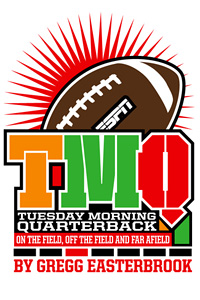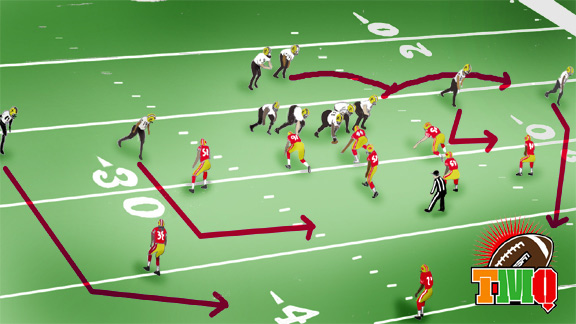You will be assimilated by the offense. Resistance is futile.

It's the year of offensive stat-a-rama throughout the NFL. There have been five 5,000-yard passing seasons in NFL history; three of them were this year. Drew Brees and Tom Brady both eclipsed the previous passing yards record in the same season. Records were set for passer rating, completion percentage and team yards from scrimmage. In the regular season, NFL teams averaged 235 gross passing yards per game, surpassing the previous high of 221 in 1995 and way above the 1971 average of 156 yards. Three of the top five rushing teams missed the playoffs while all the top five passing teams made the postseason. Detroit just gained a spectacular 882 yards passing in two games over six days -- and lost both because opponents gained 928 yards passing. The Packers and Patriots, with the league's lowest-rated defenses, just used scoreboard-spinning to win the conference top seeds. The league's No. 1 defense, the Pittsburgh Steelers, is already out of the playoffs, torched by Denver. In this year of offensive stat-a-rama, even a sputtering offense trumped the best defense!
Much of the same is happening in college football. In the Rose Bowl, Wisconsin gained 508 yards on offense, which a generation ago would have meant a walkover triumph. Wisconsin lost because Oregon gained 621 yards. The University of Houston averaged 599 yards of offense per outing. The University of Toledo played in back-to-back games in which both teams exceeded 60 points. Perhaps the Alamo Bowl represents the future of the sport. Washington gained 620 yards on offense, scored 56 points and lost, because Baylor gained 777 yards and scored 67 points.
What is going on? I journeyed alone to a distant mountaintop -- OK, a distant parking lot -- to ask the football gods. Their answer: The children of the shotgun spread have come home.
Dutch Meyer used four wide receivers in the 1940s, the trips formation has been seen for three decades, 20 years ago the no-tight-end "run and shoot" was an NFL meme, while the empty backfield has been around since Doug Flutie. These and other gonzo offensive tactics are not new developments. What is new is the near-ubiquitous proliferation of the shotgun spread and its cousin, the seven-on-seven league.
About a decade ago, multiple wide receivers with the quarterback in a shotgun began to catch on in high school and college. Using this look, in 2001, Clemson quarterback Woody Dantzler became the first player in NCAA annals to pass for 2,000 yards and rush for 1,000 yards in the same season. Shotgun spread offenses sprung up like dandelions, soon joined by the zone-read variation.
[+] Enlarge

Getty ImagesWoodrow Dantzler at Clemson -- he touched the future of football.
Around the same time, the seven-on-seven concept began to flourish. High school coaches looking for a way to evade contact-days restrictions, and make football a year-round sport, formed "passing leagues" -- essentially football without pads or linemen -- and began to play seven-on-seven all winter and spring. Seven-on-seven tournaments, unknown a generation ago, became common.
The children of the shotgun spread are advancing to the next levels. Players who spent their teen years in passing leagues -- and in seven-on-seven, everybody wants to play offense, nobody wants to be on defense -- have headed to college. A generation ago, college coaches put their best athletes on defense and tried to shut people down. In recent years, with a few exceptions such as LSU's cornerbacks, colleges have put their best athletes on offense. The boosters like shootouts. Players like to perform in shootouts, which lead to YouTube interest. "Basketball on grass" is the order of the day in college football.
And now the children of the shotgun and seven-on-seven are graduating to the pros. About five seasons ago, Indianapolis and New England went shotgun spread and rang up victory after victory. Now players arriving in the NFL don't consider the shotgun an innovation, they consider it standard tactics. Players who were raised on high school seven-on-seven have spent far more hours practicing passing than any other aspect of the game. It's what they are good at. This year Cam Newton and Tim Tebow brought the zone-read variation to the NFL. Most young offensive players are already familiar with it.
[+] Enlarge

Courtesy of Beaumont EnterpriseBecause of seven-on-seven, today's football players spend more time practicing passing than any other aspect of the sport.
At the same time, defense has moved from discipline to personal flash as its highest attainment. Ours is a visual society, and Clay Matthews -- flowing long hair, showing his biceps in wild celebrations after a sack -- is at the moment the epitome of the defensive visual. Jack Lambert would get the tackle, Bruce Smith would get the sack, then they'd just walk back to the defensive huddle. How old-fashioned! What about your sack dance!
Today's defensive players are bored by topics like tackling fundamentals or stripping blockers so a teammate can make the play: They want to generate flashy "SportsCenter" visuals like Matthews does. If that means boatloads of offensive yards surrendered for every one flashy sack, so be it. The defender who misses what should have been a routine wrap-up tackle, because he's hurled himself into space hoping to become a highlight, is as much an image of this football season as the big passing day.
Sports fads go in cycles, and Alabama-LSU, a title matchup of low-scoring power-football philosophies, may signal that the pendulum has begun to swing back. But for the moment, the children of the shotgun spread are what's happening in football. Resistance is futile, as, apparently, is playing defense.





No comments:
Post a Comment